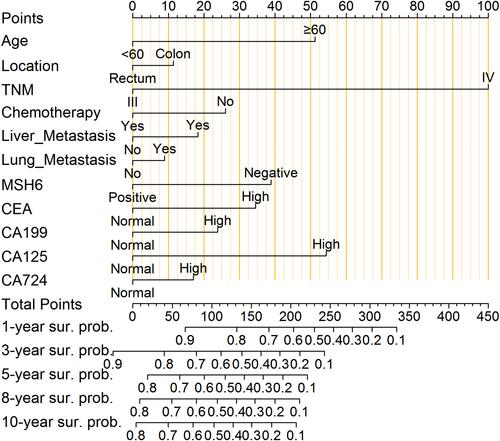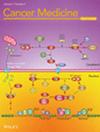Most colorectal cancer (CRC) patients are at an advanced stage when they are first diagnosed. Risk factors for predicting overall survival (OS) in advanced stage CRC patients are crucial, and constructing a prognostic nomogram model is a scientific method for survival analysis.
A total of 2956 advanced stage CRC patients were randomised into training and validation groups at a 7:3 ratio. Univariate and multivariate Cox proportional hazards regression analyses were used to screen risk factors for OS and subsequently construct a prognostic nomogram model for predicting 1-, 3-, 5-, 8- and 10-year OS of advanced stage CRC patients. The performance of the model was demonstrated by the area under the curve (AUC) values, calibration curves and decision curve analysis (DCA). Kaplan–Meier curves were used to plot the survival probabilities for different strata of each risk factor.
There was no statistically significant difference (p > 0.05) in the 32 clinical variables between patients in the training and validation groups. Univariate and multivariate Cox proportional hazards regression analyses demonstrated that age, location, TNM, chemotherapy, liver metastasis, lung metastasis, MSH6, CEA, CA199, CA125 and CA724 were risk factors for OS. We estimated the AUC values for the nomogram model to predict 1-, 3-, 5-, 8- and 10-year OS, which in the training group were 0.826 (95% CI: 0.807–0.845), 0.836 (0.819–0.853), 0.839 (0.820–0.859), 0.835 (0.809–0.862) and 0.825 (0.779–0.870) respectively; in the validation group, the corresponding AUC values were 0.819 (0.786–0.852), 0.831 (0.804–0.858), 0.830 (0.799–0.861), 0.815 (0.774–0.857) and 0.802 (0.723–0.882) respectively. Finally, the 1-, 3-, 5-, 8- and 10-year OS rates for advanced stage CRC patients were 73.4 (71.8–75.0), 49.5 (47.8–51.4), 43.3 (41.5–45.2), 40.1 (38.1–41.9) and 38.6 (36.6–40.8) respectively.
We constructed and validated an original nomogram for predicting the postoperative OS of advanced stage CRC patients, which can help facilitates physicians to accurately assess the individual survival of postoperative patients and identify high-risk patients.



